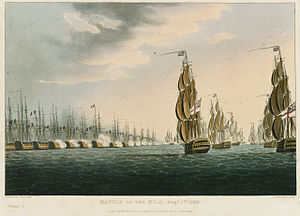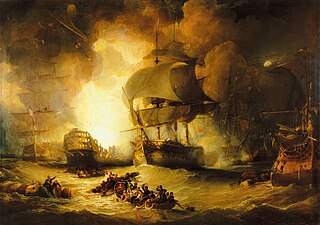
The Battle of the Nile was a major naval battle fought between the British Royal Navy and the Navy of the French Republic at Aboukir Bay on the Mediterranean coast off the Nile Delta of Egypt from the 1st to the 3rd of August 1798. The battle was the climax of a naval campaign that had raged across the Mediterranean during the previous three months, as a large French convoy sailed from Toulon to Alexandria carrying an expeditionary force under General Napoleon Bonaparte. The British fleet was led in the battle by Rear-Admiral Sir Horatio Nelson; they decisively defeated the French under Vice-Admiral François-Paul Brueys d'Aigalliers.

HMS Canopus was an 84-gun third rate ship of the line of the British Royal Navy. She had previously served with the French Navy as the Tonnant-classFranklin, but was captured after less than a year in service by the British fleet under Rear Admiral Horatio Nelson at the Battle of the Nile in 1798. Having served the French for less than six months from her completion in March 1798 to her capture in August 1798, she eventually served the British for 89 years.

HMS Malta was an 80-gun third rate ship of the line of the Royal Navy. She had previously served with the French Navy as the Tonnant-classGuillaume Tell, but was captured in the Mediterranean in 1800 by a British squadron enforcing the blockade of French-occupied Malta. Having served the French for less than four years from her completion in July 1796 to her capture in March 1800, she would eventually serve the British for forty years.

The Battle of the Nile was a significant naval action fought during 1–3 August 1798. The battle took place in Aboukir Bay, near the mouth of the River Nile on the Mediterranean coast of Egypt and pitted a British fleet of the Royal Navy against a fleet of the French Navy. The battle was the climax of a three-month campaign in the Mediterranean during which a huge French convoy under General Napoleon Bonaparte had sailed from Toulon to Alexandria via Malta. Despite close pursuit by a British fleet of thirteen ships of the line, one fourth rate and a sloop under Sir Horatio Nelson, the French were able to reach Alexandria unscathed and successfully land an army, which Bonaparte led inland. The fleet that had escorted the convoy, consisting of thirteen ships of the line, four frigates and a number of smaller vessels under Vice-amiral François-Paul Brueys D'Aigalliers, anchored in Aboukir Bay as Alexandria harbour was too narrow, forming a line of battle that was protected by shoals to the north and west.
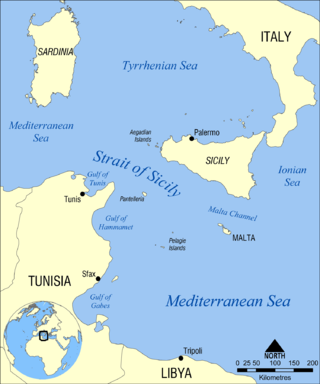
The action of 27 June 1798 was a minor naval engagement between British and French frigates in the Strait of Sicily in the Mediterranean Sea. The engagement formed part of a wider campaign, in which a major French convoy sailed from Toulon to Alexandria at the start of the Napoleonic campaign in Egypt. The French frigate Sensible had been detached from the convoy after the capture of Malta, under orders to carry wounded soldiers and looted treasure back to France while the main body continued to Egypt. The British frigate HMS Seahorse was one of a number of vessels detached from the main British Mediterranean Fleet in the Tagus River, sent to augment the fleet under Sir Horatio Nelson that was actively hunting the French convoy.
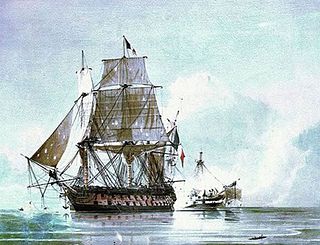
The action of 18 August 1798 was a minor naval engagement of the French Revolutionary Wars, fought between the British fourth rate ship HMS Leander and the French ship of the line Généreux. Both ships had been engaged at the Battle of the Nile three weeks earlier, in which a British fleet under Rear-Admiral Sir Horatio Nelson had destroyed a French fleet at Aboukir Bay on the Mediterranean coast of Egypt. Généreux was one of only four French ships to survive the battle, while Leander had been detached from the British fleet by Nelson on 6 August. On board, Captain Edward Berry sailed as a passenger, charged with carrying despatches to the squadron under Earl St Vincent off Cadiz. On 18 August, while passing the western shore of Crete, Leander was intercepted and attacked by Généreux, which had separated from the rest of the French survivors the day before.

The action of 15 July 1798 was a minor naval battle of the French Revolutionary Wars, fought off the Spanish Mediterranean coast by the Royal Navy ship of the line HMS Lion under Captain Manley Dixon and a squadron of four Spanish Navy frigates under Commodore Don Felix O'Neil. Lion was one of several ships sent into the Western Mediterranean by Vice-Admiral Earl St Vincent, commander of the British Mediterranean Fleet based at the Tagus in Portugal during the late spring of 1798. The Spanish squadron was a raiding force that had sailed from Cartagena in Murcia seven days earlier, and was intercepted while returning to its base after an unsuccessful cruise. Although together the Spanish vessels outweighed the British ship, individually they were weaker and Commodore O'Neil failed to ensure that his manoeuvres were co-ordinated. As a result, one of the frigates, Santa Dorotea, fell out of the line of battle and was attacked by Lion.

The siege of Malta, also known as the siege of Valletta or the French blockade, was a two-year siege and blockade of the French garrison in Valletta and the Three Cities, the largest settlements and main port on the Mediterranean island of Malta, between 1798 and 1800. Malta had been captured by a French expeditionary force during the Mediterranean campaign of 1798, and garrisoned with 3,000 soldiers under the command of Claude-Henri Belgrand de Vaubois. After the British Royal Navy destroyed the French Mediterranean Fleet at the Battle of the Nile on 1 August 1798, the British were able to initiate a blockade of Malta, assisted by an uprising among the native Maltese population against French rule. After its retreat to Valletta, the French garrison faced severe food shortages, exacerbated by the effectiveness of the British blockade. Although small quantities of supplies arrived in early 1799, there was no further traffic until early 1800, by which time starvation and disease were having a disastrous effect on the health, morale, and combat capability of the French troops.
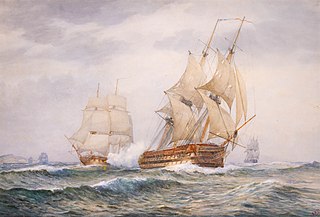
The Battle of the Malta Convoy was a naval engagement of the French Revolutionary Wars fought on 18 February 1800 during the Siege of Malta. The French garrison at the city of Valletta in Malta had been under siege for eighteen months, blockaded on the landward side by a combined force of British, Portuguese. and irregular Maltese forces and from the sea by a Royal Navy squadron under the overall command of Lord Nelson from his base at Palermo on Sicily. In February 1800, the Neapolitan government replaced the Portuguese troops with their own forces and the soldiers were convoyed to Malta by Nelson and Lord Keith, arriving on 17 February. The French garrison was by early 1800 suffering from severe food shortages, and in a desperate effort to retain the garrison's effectiveness a convoy was arranged at Toulon, carrying food, armaments and reinforcements for Valletta under Contre-amiral Jean-Baptiste Perrée. On 17 February, the French convoy approached Malta from the southeast, hoping to pass along the shoreline and evade the British blockade squadron.

The action of 31 March 1800 was a naval engagement of the French Revolutionary Wars fought between a Royal Navy squadron and a French Navy ship of the line off Malta in the Mediterranean Sea. By March 1800 Valletta, the Maltese capital, had been under siege for eighteen months and food supplies were severely depleted, a problem exacerbated by the interception and defeat of a French replenishment convoy in mid-February. In an effort to simultaneously obtain help from France and reduce the number of personnel maintained in the city, the naval commander on the island, Contre-amiral Pierre-Charles Villeneuve, ordered his subordinate Contre-amiral Denis Decrès to put to sea with the large ship of the line Guillaume Tell, which had arrived in the port shortly before the siege began in September 1798. Over 900 men were carried aboard the ship, which was to sail for Toulon under cover of darkness on 30 March.
The action of 19 December 1796 was a minor naval engagement of the French Revolutionary Wars, fought in the last stages of the Mediterranean campaign between two British Royal Navy frigates and two Spanish Navy frigates off the coast of Murcia. The British squadron was the last remaining British naval force in the Mediterranean, sent to transport the British garrison of Elba to safety under the command of Commodore Horatio Nelson. The Spanish under Commodore Don Jacobo Stuart were the vanguard of a much larger squadron. One Spanish frigate was captured and another damaged before Spanish reinforcements drove the British off and recaptured the lost ship.
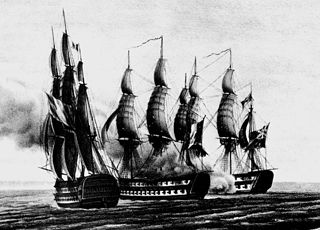
Ganteaume's expeditions of 1801 were three connected major French Navy operations of the spring of 1801 during the French Revolutionary Wars. A French naval squadron from Brest under Contre-amiral Honoré Ganteaume, seeking to reinforce the besieged French garrison in Ottoman Egypt, made three separate but futile efforts to reach the Eastern Mediterranean. The French army in Egypt had been trapped there shortly after the start of the Napoleonic campaign in Egypt in 1798, when the French Mediterranean Fleet was destroyed at the Battle of the Nile. Since that defeat, the French Navy had maintained only a minimal presence in the Mediterranean Sea, while the more numerous British and their allies had succeeded in blockading and defeating several French bases almost unopposed.

The action of 24 June 1801 was a minor naval engagement during the French Revolutionary Wars. A British ship of the line, HMS Swiftsure under Captain Benjamin Hallowell was passing westwards through the Southern Mediterranean near Cape Derna when it encountered a much larger French squadron under Contre-Amiral Honoré Ganteaume that was also returning westwards after a failed attempt to reinforce the besieged French garrison in Egypt. Although Hallowell immediately recognised the danger his vessel was in and turned to flee, the French ships were much faster and soon closed with his ship. At 14:00, three French vessels were within long gunshot and Hallowell decided that his only hope of escape lay in disabling the three ships before the rest of the French squadron could join the engagement. Turning towards the enemy, Hallowell found that his sluggish ship was unable to respond rapidly to French manoeuvres and within two hours Swiftsure was surrounded. Threatened with complete destruction and unable to escape, the British captain surrendered.

The action of 13 October 1796 was a minor naval engagement of the French Revolutionary Wars, fought off the Mediterranean coast of Spain near Cartagena between the British Royal Navy 32-gun frigate HMS Terpsichore under Captain Richard Bowen and the Spanish Navy 34-gun frigate Mahonesa under Captain Tomás de Ayalde. The action was the first battle of the Anglo-Spanish War, coming just eight days after the Spanish declaration of war. In a battle lasting an hour and forty minutes, Mahonesa was captured.

The Algeciras campaign was an attempt by a French naval squadron from Toulon under Contre-Admiral Charles Linois to join a French and Spanish fleet at Cadiz during June and July 1801 during the French Revolutionary Wars prior to a planned operation against either Egypt or Portugal. To reach Cadiz, the French squadron had to pass the British naval base at Gibraltar, which housed the squadron tasked with blockading Cadiz. The British squadron was commanded by Rear-Admiral Sir James Saumarez. After a successful voyage between Toulon and Gibraltar, in which a number of British vessels were captured, the squadron anchored at Algeciras, a fortified port city within sight of Gibraltar across Gibraltar Bay. On 6 July 1801, Saumarez attacked the anchored squadron, in the First Battle of Algeciras. Although severe damage was inflicted on all three French ships of the line, none could be successfully captured and the British were forced to withdraw without HMS Hannibal, which had grounded and was subsequently seized by the French.
The French brig Alerte was launched in April 1787. The Royal Navy captured her at Toulon in August 1793, and renamed her HMS Vigilante. The British set her on fire when they evacuated Toulon in December of that year. After the French rebuilt her as Alerte, she served at the Battle of Aboukir Bay. The British recaptured her in June 1799 and took her into service as HMS Minorca. Minorca was sold in 1802.

François-Paul Brueys d'Aigalliers, Comte de Brueys was a French naval officer who fought in the American War of Independence and as a commander in the French Revolutionary Wars. He led the French fleet in the Mediterranean campaign of 1798 until his death at the Battle of the Nile, at the rank of Vice-Admiral. He was also a Freemason in the La Bonne Foi lodge at Montauban.
The Croisière de Bruix was the principal naval campaign of the year 1799 during the French Revolutionary Wars. The expedition began in April 1799 when the bulk of the French Atlantic Fleet under Vice-Admiral Étienne Eustache Bruix departed the base at Brest, evading the British Channel Fleet which was blockading the port and tricking the commander Admiral Lord Bridport into believing their true destination was Ireland. Passing southwards, the French fleet narrowly missed joining with an allied Spanish Navy squadron at Ferrol and was prevented by an easterly gale from uniting with the main Spanish fleet at Cádiz before entering the Mediterranean Sea. The Mediterranean was under British control following the destruction of the French Mediterranean Fleet at the Battle of the Nile in August 1798, and a British fleet nominally under Admiral Earl St Vincent was stationed there. Due however to St. Vincent's ill-health, operational control rested with Vice-Admiral Lord Keith. As Keith sought to chase down the French, the Spanish fleet followed Bruix into the Mediterranean before being badly damaged in a gale and sheltering in Cartagena.
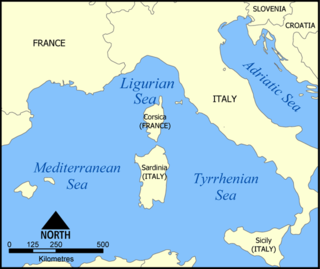
The Battle of the Hyères Islands was a naval engagement fought between a combined British and Neapolitan fleet and the French Mediterranean Fleet on 13 July 1795 during the French Revolutionary Wars. Since the start of the war in 1793 the French fleet had suffered a series of damaging defeats and was restricted to limited operations off the French Mediterranean Coast in the face of a determined allied blockade. The French fleet, commanded by Pierre Martin, had sought to test the blockade during 1795, and in March had been caught by the British, under William Hotham, in the Gulf of Genoa. At the ensuing Battle of Genoa two French ships were captured before Martin was able to retreat to a safe anchorage.

The Mediterranean campaign of 1793–1796 was a major theater of conflict in the early years of the French Revolutionary Wars. Fought during the War of the First Coalition, the campaign was primarily contested in the Western Mediterranean between the French Navy's Mediterranean Fleet, based at Toulon in Southern France, and the British Royal Navy's Mediterranean Fleet, supported by the Spanish Navy and the smaller navies of several Italian states. Major fighting was concentrated in the Ligurian Sea, and focused on British maintenance of and French resistance to a British close blockade of the French Mediterranean coast. Additional conflict spread along Mediterranean trade routes, contested by individual warships and small squadrons.




